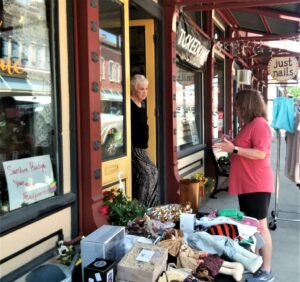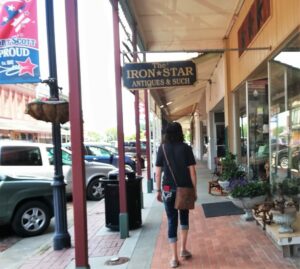|
|
|
|
|
|
|
|
|
|
|
|
|
|
|
|
|
|
|
|
|
|
|
|
|
|
|
|
|
|
|
|
|
|
|
|
|
|
|
|
|
|
|
|
|
|
|
|
|

Stewart Realty Company is pleased to announce that Diann Tucker, owner/broker, has been selected as the recipient for the 2020 Best of Fort Scott Awards in the category of Real Estate Agency.
This designation and the plaque presentation were created to honor and generate public recognition of the achievements and positive contributions of businesses and organizations in and around Fort Scott.
The mission of this award recognition is to raise the profile of exemplary companies and entrepreneurs among the business community and general public.
Selection as a 2020 Award Winner is determined by the marketing success of an organization in the local community within a specific category. The award program uses empirical data supplied by independent third-parties as input into the award algorithm, and is not based on nominations, voting, contests or surveys.
Diann Tucker was also inducted as a 2019 award winner from Trademark Women of Distinction for demonstrating dedication, leadership, and professional ethics in her community.
The award committee stated that “ Her compassion and expertise has helped set the standard in the local real estate industry as a dedicated professional. The personal touch she adds to her relationship with everyone she does business with is her way of helping people make real estate choices that change lives. Her proven track record of quality service has made her mark on local business integrity.”
Congratulations to Diann Tucker and Stewart Realty for this Best of 2020 Fort Scott award in the field of Real Estate.
The Bourbon County Economic Director announces that Bourbon County was awarded $132,000 Community Development Block Grant-CV Grant for county businesses.
“We will announce open applications as soon as we can, we know you are eager to obtain relief,” Jody Hoener said. “The granting process will be based on a scoring algorithm that will be widely available.”
“The grant’s purpose is for job retention,” she said. ” In addition to year-round employment, our priorities in granting will also include closure/impact to operations, other relief awarded, and food system supply chain impact.”
To view the news release from the Department of Commerce click here:
https://www.wibwnewsnow.com/66-kansas-cities-and-counties-to-receive-community-development-block-grants-to-support-coronavirus-response/
“If you have any questions at all do not hesitate to reach out,” she said.
She can be reached at
1-620-223-3800
1-620-215-5725 Mobile
www.bourboncountyks.org
66 Kansas cities and counties to receive Community Development
Block Grants to support coronavirus response
Editors note: Both The City of Fort Scott and Bourbon County Commission will receive $132,000.
Governor Laura Kelly announced today the award of nearly $9 million in Community Development Block Grant Coronavirus Response Supplement (CDBG-CV) funds to 66 Kansas communities.
“Kansans have faced unprecedented challenges during the past few months due to COVID-19,” Governor Kelly said. “Our communities need relief – and they need it now. I’m pleased to announce additional resources to help Kansans navigate through the recovery process. These grants will help our communities rebuild their economies and support Kansas families.”
Grants were available in two categories – Economic Development and Meal Programs. Economic Development grants provide communities with funding to help local businesses retain jobs for low-to-moderate income people by covering working capital expenses such as inventory, wages and utilities. Meal Program grants can be directed toward organizations such as Meals on Wheels, local food banks or to support organizations providing meals for children affected by the loss of school meal programs.
“The COVID-19 crisis has left many communities searching for resources to support their residents and businesses,” Secretary of Commerce David Toland said. “The CDBG-CV award provides cities and counties the ability to determine where the greatest need in their community lies and to provide some relief as we move into the recovery phase of the crisis.”
CDBG funds are one of Commerce’s primary tools in supporting the state’s small, predominantly rural communities. CDBG-CV grants are part of the state’s allocation from the federal Coronavirus Aid, Relief, and Economic Security (CARES) Act and are designed to help Kansas communities respond to the needs of their residents and businesses during the reopening phase of the state.
The following communities are recipients of CDBG-CV awards.
| Recipient | Award Amount |
| Abilene | $132,000 |
| Allen County | $132,000 |
| Anderson County | $132,000 |
| Atchison | $132,000 |
| Baldwin City | $132,000 |
| Beloit | $132,000 |
| Bourbon County | $132,000 |
| Chanute | $132,000 |
| Cherokee County | $169,200 |
| Cimarron | $132,000 |
| Clay County | $132,000 |
| Cloud County | $132,000 |
| Coffeyville | $167,000 |
| Crawford County | $132,000 |
| Derby | $132,000 |
| Dodge City | $132,000 |
| Ellsworth | $132,000 |
| Ellsworth County | $132,000 |
| Emporia | $167,000 |
| Eudora | $132,000 |
| Eureka | $167,000 |
| Fort Scott | $132,000 |
| Franklin County | $132,000 |
| Garden City | $132,000 |
| Garnett | $132,000 |
| Girard | $169,200 |
| Gove County | $132,000 |
| Graham County | $167,000 |
| Harper | $152,000 |
| Horton | $167,000 |
| Hoxie | $173,600 |
| Hutchinson | $132,000 |
| Independence | $167,000 |
| Jackson County | $132,000 |
| Jewell County | $132,000 |
| Junction City | $167,000 |
| Labette County | $132,000 |
| Liberal | $132,000 |
| Linn County | $132,000 |
| Louisburg | $132,000 |
| Marion County | $167,000 |
| Marquette | $66,000 |
| Marshall County | $132,000 |
| McPherson | $132,000 |
| Mitchell County | $132,000 |
| Montgomery County | $132,000 |
| Mulvane | $132,000 |
| Neosho County | $169,200 |
| Oberlin | $80,600 |
| Osborne County | $132,000 |
| Ottawa | $132,000 |
| Parsons | $132,000 |
| Phillips County | $132,000 |
| Pittsburg | $170,300 |
| Pleasanton | $132,000 |
| Reno County | $132,000 |
| Russell County | $173,600 |
| Scott County | $132,000 |
| Sheridan County | $132,000 |
| Sherman County | $132,000 |
| Smith County | $132,000 |
| Thomas County | $132,000 |
| Unified Greeley County | $55,000 |
| Wallace County | $132,000 |
| Wilson | $77,000 |
| Wilson County | $132,000 |
To date, the Department of Commerce has received 106 award applications totaling more than $32 million. Applications were processed on a first-come, first-served basis. While all funds for this round of CDBG-CV have been awarded, the Department of Commerce expects to receive approximately $7 million in additional funding in a second round of CDBG funds through the CARES Act. More information will be announced as it’s made available from the U.S. Department of Housing and Urban Development.
For more information on the Community Development Block Grant Coronavirus Response Supplement program visit www.kansascommerce.gov/cdbg-cv/.
For current information on COVID-19 in Kansas, go to covid.ks.gov/.
|
|
|
|
|
|
|
|
|
State sees total tax collection growth over April Consensus Revenue Estimates; attributes to online sales and withholding taxes
TOPEKA –The State of Kansas saw total tax collections for May Fiscal Year 2020 at $448.7 million; 6.6% or $27.8 million above the estimate. That is down 20.3% or $114.4 million compared to the same month last fiscal year.
Individual income tax collections were up $5.9 million or 2.8% compared to the estimate with $215.9 million collected. That is 22.3% or $62.0 million less than last May. The increase from the estimate can be attributed to reduced bond payments from withholding and an extra payroll period for the semi-monthly withholding tax filings. Corporate income tax collection receipts were down 167.9% or $8.4 million from the estimate at negative $3.4 million. This is due to the state processing more refunds than it received in corporate income tax collections. When compared to the same month last fiscal year, those collections are down $14.4 million.
Retail sales tax collections were $18.9 million or 12.2% more than estimated with $173.9 million collected.
Compared to May of last fiscal year, collections are down $27.3 million or 13.6%.
Compensating use tax collections are 25.5% or $7.7 million more than expected at $37.7 million.
When looking at last year’s numbers, these collections are $1.2 million or 3.2% more than May of last fiscal year.
This can be attributed to the increased registration of online retailers to collect and remit Kansas taxes.
On average, the state is seeing 300 new registrations per month.
For detailed info:
11_May_Revenue_FY2020_06-01-2020_Final

It was difficult to find a parking spot on Main Street in downtown Fort Scott on Saturday.
The Fort Scott Chamber of Commerce hosted the Merchant Madness Sidewalk Sale and invited shoppers to come shopping.
The mild weather and recent reopening of businesses during the COVID 19 pandemic made for a perfect day to go shopping.
Another Merchant Sale And Town-Wide Garage Sale
Another town-wide sale is coming soon and this time includes all those who want to clean out closets and garages.
On June 12-13 retailers will be celebrating National Flag Week, according to a press release from the Fort Scott Chamber of Commerce.
With any purchase, shoppers will receive a souvenir American Flag and also they can fill out a Trivia Card to enter them into a drawing for $50 Chamber Of Commerce Bucks.
Also on that weekend of June 12-13, there will be a Spring Town-Wide Garage Sale.
To register one’s sale which will be printed on a garage sale map, call the Fort Scott Chamber of Commerce at 620. 223.3566. Sellers may also sign up at Bids & Dibs, 108 Scott Ave.
The cost is $10 to be added to the map.
All customers are to use hand sanitizer at every yard sale before touching merchandise and homeowner should have this available, also practice social distancing of being 6-feet apart, according to the press release.
Photos of some the participating retailers in the Merchant Madness Sidewalk Sale:




June Schedule:
6/4 ~ Chamber Coffee at Sunshine Boutique (Will confirm if canceled) 8 am
6/4 ~ Old Fort Auto Grand Opening Event & Ribbon Cutting at 5:15 pm
6/5 thru 6/7 ~ Bourbon County Bulldogging Bash – Fairgrounds
6/5 ~ Honorary Good Ol Days Cruise Night, starts at 6 pm
6/6 ~ 9th Annual Tiger Baseball Golf Tournament at Woodland Hills Golf Course, Benefit to raise money for the Baseball Program. Starts at 8:30 am
6/11 ~ Chamber Coffee at Briggs of Fort Scott, celebrating 4 years!
6/12 & 6/13 ~ Spring Town-Wide Garage Sale (call the chamber and register your yard sale to be put on the printed map!) Also can sign up at Bids & Dibs, the cost is $10.00. All customers are to use hand sanitizer at every yard sale before touching merchandise and homeowner should have this available and practice social distancing.
6/12 & 13 ~ Retailers will be open for shopping as well with celebrating National Flag Week. With any purchase, shoppers will receive a souvenir American Flad and also they can fill out a Trivia Card to enter them into a drawing for $50 Chamber Bucks!
13 ~ Elks Lodge 579 City Fireworks Display Fundraiser – 3 Person Scramble at Woodland Hills Golf Course
18 ~ The Bourbon County Garden Club hosting Chamber Coffee
21 ~ USD 235 – Uniontown HS Graduation
25 ~ Old Fort Auto will host the Chamber Coffee.


Call to reserve your spot on the Briggs Movie Lot at 620.644.9927

